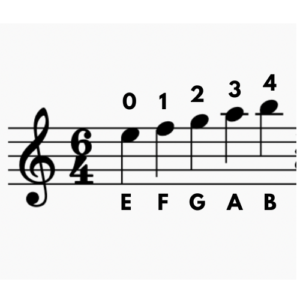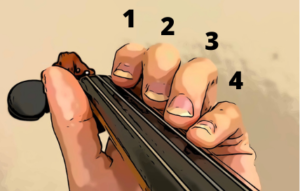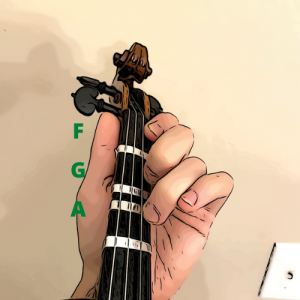Violin E string notes and fingering: Notes and tips
The main notes while playing on the E string are open E, F, G, A, and B. These are natural or diatonic notes and can be altered with sharps and flats.


1.When playing the violin please remember that the number assigned to each finger is not the same as on a piano keyboard and starts with the index finger as the first finger, middle as the second, etc.
2.Play sharps or flats with the same finger by moving it higher or lower from the diatonic note. Remember about the distance between half steps and whole steps. When playing half steps, put your fingers very close to each other, with no space between them, to play in tune.
A common mistake among beginners is not paying attention to the distance between their fingers, which results in false intonation and playing out of tune.
3.Remember to maintain good posture and angle of the left hand and fingers. Keep it free and relaxed. If you feel tension in your fingers or muscles then it is time to revise your left-hand angle and its position.
In general, if you have an ascending melodic line, you need to keep all preceding fingers on the fingerboard. For instance, if you play F, G, and are going to play A note next, keep your first and second fingers on the string

Violin E string notes fingerings and hand placement. Get rid of tension in the left hand
Physical aspects of the left hand and fingering on the E string. Get rid of tension
- Place the fingers over the string where you should be able to drop and lift them from their base joins.
- Don’t clench the neck with the thumb and the first finger. The thumb should hover over the side of the neck freely.
- Keep your fingers rounded and relaxed. Apply only a sufficient amount of pressure to move the string closer to the fingerboard so it touches it slightly.
- The forearm should be almost vertical or brought a little bit outward depending on the violin placement and the tilt of the instrument. You want to place the fingers on the E string at the same angle as when you play on the G string. The left-hand elbow moves slightly inward for each successive lower string.
- When playing with the fourth finger, consider moving its base knuckle closer to the neck to reduce stretching and unnecessary tension. Keep the wrist straight and rotated clockwise so it stays parallel to the edge of the fingerboard. Exercises for the left hand such as Sevcik or Shradieck will help to strengthen your fingers if you use them consistently.
- Don’t force the left hand to physical strain. If you feel that it’s not flexible enough then warm it up a little bit. It is good to establish an everyday warm-up routine before playing the violin.
More about:
Violin fingering- G string pinkie placement- read here
How to hold a violin bow for beginners- read here
Vibrato on violin: How to do it effortlessly
I would love to answer any questions related to violin lessons and violin playing. You can email me at [email protected] or book your free trial lesson here.
